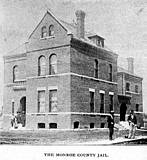
The Monroe County Jail
234
CHAPTER XIV
The County Jail and County Finances
At the June session of the Monroe County
Board of Supervisors of 1891 a petition, signed by 227 citizens and taxpayers of
the county, praying the submission of a proposition to build a county jail and
jailer's residence in Albia at a cost of $12,000, was submitted to the Board for
action, in the premises.
The proposition was voted upon at the general
election and carried by a vote of 1,412 in favor of, and 814 against, the
measure.
Accordingly, at the June session of the Board
of 1892 that body ordered that the county be bonded in the sum of $25,000,
$12,000 of which was to apply to the building of the
235
jail and jailer's residence, and $13,000 to be applied in
liquidation of the county's indebtedness, and to be known as the county bond
fund. These bonds were issued in sums of one thousand dollars each, and bore 5
per cent interest, payable semi annually. They were to mature in 1902; but the
county reserved the right to redeem them before maturity in the following
manner: those numbered from 1 to 12 to be paid any time before maturity, and
those numbered from 13 to 25, both inclusive, to be paid any time after five
years, and before maturity.
Prior to the $25,000 issue, there were $3,500
of old bonds outstanding, held by Cleveland (Ohio) parties. These our County
Treasurer paid off May 25, 1896.
In the present year (1896) an additional bond
levy of $20,000 was made to meet current indebtedness.
None of the principal of the $25,000 has been
paid, so far; but at present there is on hands in the county treasury the
following available funds: county funds, $4,290.46; jail funds, $4,719.87.
This
amount can be paid on bonds at any time, towards liquidating the principal and
meeting the semi annual interest, which latter becomes due in July.
The First National Bank of Albia holds all
the bonds now outstanding, and took them at a liberal premium. The late $20,000
issue matures in 1906, but may be paid at any time prior to that date.
For several years the county tax levy has
been placed at the highest limit authorized by law; and yet the county, year
after year, has been running behind in its current indebtedness, and if some
remedy is not soon interposed, embarrassing results will ensue ere long. There
is but one way to remedy the evil, and that is to require township assessors to
assess property at its actual value. There are grave defects in the present
system of levying county taxes, and the County Board ought to exercise closer
and more judicious supervision in the matter than it has hitherto shown.
The consolidated tax levy for 1896 was 15
3-10 mills, and while the county levy was 6 mills - the maximum limit prescribed
by law - the entire levy consolidated is not up to the maximum limit. The county
bond tax is also placed at the highest limit.
The statutes authorize the Board of
Supervisors to assess and levy each year on the taxable property of the county,
in addition to the levy authorized for other purposes,
236
a sufficient sum to pay the interest on outstanding bonds
accruing before the next annual levy, and any portion of the principal which, at
the end of three years, the sum raised shall equal at least 20 per cent of the
amount of the bonds issued; at the end of five years, at least 40 per cent of
the amount; and at and before the date of maturity of the bonds shall be equal
to the whole amount of the principal and interest. Such money arising from these
levies constitutes the bond fund. This bond fund cannot be used for any other
purpose.
Under the provisions of the code, the Board
of Supervisors have the power to levy a tax of 1/2 mill on the dollar to pay off
these bonds, if the annual levy is found insufficient, and this provision does
not hinder the county from adopting a still higher levy; but the proposition has
to be first submitted to the people for approval.
The county tax of 6 mills can also be
increased by special act of the Legislature, but the proposition would also have
to be submitted to the people for their approval, and they would vote it down.
There is always a disposition on the part of the people to cry down any
proposition to increase taxation, and, on the other hand, they call loudly for
"lower taxes, lower taxes"; but in the midst of this popular cry there
is a financial skeleton lurking in the county's closet - a "Banquo's
ghost," continually rising and pointing with its finger to the accumulating
indebtedness of the county.
The County Board has always used the utmost
economy in making appropriations, and the building of the county jail was a wise
and economic measure. Prior to its construction prisoners were taken to jails in
adjoining counties, at considerable expense. For instance, if a prisoner had to
be transferred to Chariton, twenty five miles distant, the sheriff was allowed
10 cents per mile milage or $2.50; and 40 cents an hour for services, which made
$5 or $6 more; then the prisoner's and officer's transportation should be added,
and the amount is considerable. Monroe County has a splendid and amply secure
jail, and it well worth every cent of its cost.